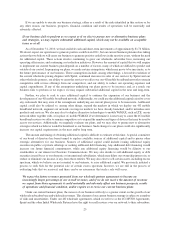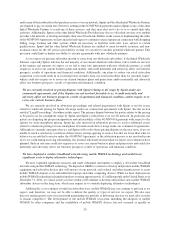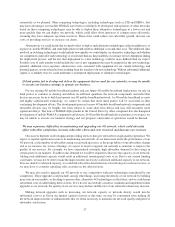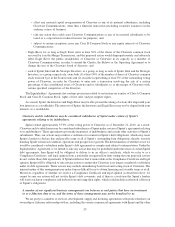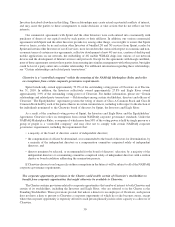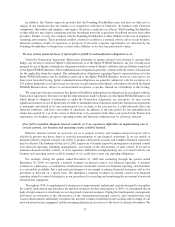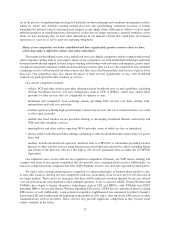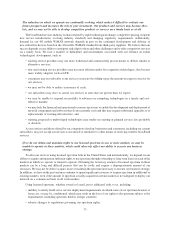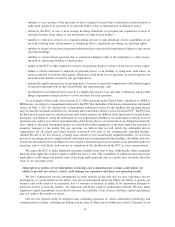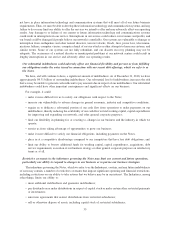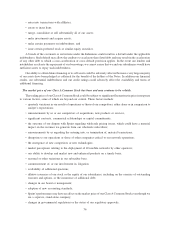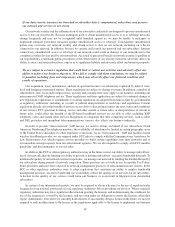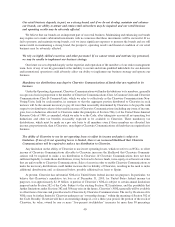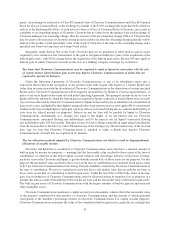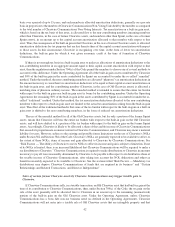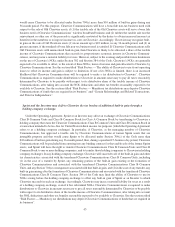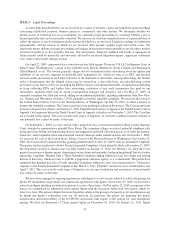Clearwire 2010 Annual Report Download - page 40
Download and view the complete annual report
Please find page 40 of the 2010 Clearwire annual report below. You can navigate through the pages in the report by either clicking on the pages listed below, or by using the keyword search tool below to find specific information within the annual report.not have in place information technology and communication systems that will meet all of our future business
requirements. Thus, we must be able to develop these information technology and communication systems, and any
failure to do so may limit our ability to offer the services we intend to offer and may adversely affect our operating
results. Any damage to or failure of our current or future information technology and communications systems
could result in interruptions in our service. Interruptions in our service could reduce our revenues and profits, and
our brand could be damaged if people believe our network is unreliable. Our systems are vulnerable to damage or
interruption from earthquakes and other natural disasters, terrorist attacks, floods, fires, power loss, telecommu-
nications failures, computer viruses, computer denial of service attacks or other attempts to harm our systems, and
similar events. Some of our systems are not fully redundant, and our disaster recovery planning may not be
adequate. The occurrence of a natural disaster or unanticipated problems at our network centers could result in
lengthy interruptions in our service and adversely affect our operating results.
Our substantial indebtedness could adversely affect our financial flexibility and prevent us from fulfilling
our obligations under the notes issued in connection with our recent debt offerings, which we refer to as
the Notes.
We have, and will continue to have, a significant amount of indebtedness. As of December 31, 2010, we have
approximately $4.31 billion of outstanding indebtedness. Our substantial level of indebtedness increases the risk
that we may be unable to generate cash sufficient to pay amounts due in respect of our indebtedness. Our substantial
indebtedness could have other important consequences and significant effects on our business.
For example, it could:
• make it more difficult for us to satisfy our obligations with respect to the Notes;
• increase our vulnerability to adverse changes in general economic, industry and competitive conditions;
• require us to dedicate a substantial portion of our cash flow from operations to make payments on our
indebtedness, thereby reducing the availability of our cash flow to fund working capital, capital expenditures
for improving and expanding our network, and other general corporate purposes;
• limit our flexibility in planning for, or reacting to, changes in our business and the industry in which we
operate;
• restrict us from taking advantage of opportunities to grow our business;
• make it more difficult to satisfy our financial obligations, including payments on the Notes;
• place us at a competitive disadvantage compared to our competitors that have less debt obligations; and
• limit our ability to borrow additional funds for working capital, capital expenditures, acquisitions, debt
service requirements, execution of our business strategy or other general corporate purposes on satisfactory
terms or at all.
Restrictive covenants in the indentures governing the Notes may limit our current and future operations,
particularly our ability to respond to changes in our business or to pursue our business strategies.
The indentures governing the Notes, which we refer to as the Indentures, contain, and any future indebtedness
of ours may contain, a number of restrictive covenants that impose significant operating and financial restrictions,
including restrictions on our ability to take actions that we believe may be in our interest. The Indentures, among
other things, limits our ability to:
• incur additional indebtedness and guarantee indebtedness;
• pay dividends on or make distributions in respect of capital stock or make certain other restricted payments
or investments;
• enter into agreements that restrict distributions from restricted subsidiaries;
• sell or otherwise dispose of assets, including capital stock of restricted subsidiaries;
35


